No wonder that Formatville's motto is:
"Live by its 10 commandments or" - like Donnie Brasco would say - "Fuhgeddaboudit"
So if you want YOUR screenplay to be read and not tossed, apply these script formatting guidelines. Today part 2 of the sixth commandment.
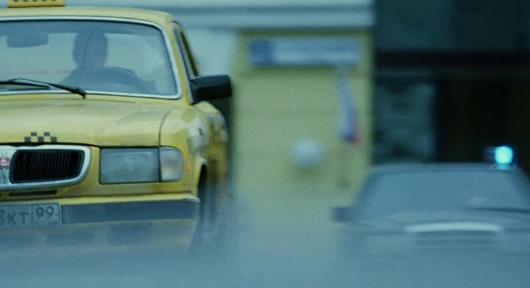
We asked our format expert, Matt, aka Formatman, to lead us through the 10 screenplay formatting commandments.
In his previous article he covered:
Time to go to Part 3 and his Top 6 Common Car Actions.
Formatman:
Sounds familiar? you watch a movie and suddenly wonder: how's the screenplay format of that scene?
Well, wonder no more, we've made a top 6 of the common car actions.
Remember that there's NOT one screenplay format to express these situations, this is just one way that got used by some famous screenwriters. But you'll learn plenty.
This is a frequent situation. The character sits in the car. Suddenly, out of nowhere, someone knocks on the window. The character is startled.
A variation is when the character sees someone / a crowd slapping the windows of the car and is helpless about it, which causes even more emotion.
This is the screenplay format of a grabbing scene of Argo, screenplay written by Chris Terrio
EXT. TEHRAN - DAY Tony drives the minivan through streets of Tehran. The Houseguests sit in silence, looking out the windows. There is a vehement DEMONSTRATION going on -- stars-and- stripes burning in Molavi Square -- and it's taking place right in their way. They stop at the demonstration, then realize people aren't passing by as much as celebrating in the street. Tony is forced to nose his way through the crowd -- chanting and yelling -- some SLAPPING THE WINDOWS.
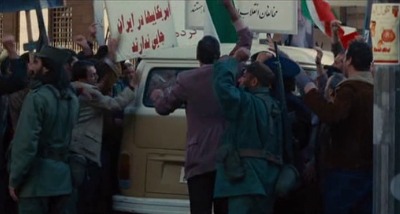
This time the character is in his house. We hear a car stopping outside. Its lights reflect inside the character's house.
This is the screenplay format of a scene of Flight, screenplay written by John Gatins
THE TELEVISION IN WHIP'S LIVING ROOM - NIGHT We are now in WHIP's living room watching HOME MOVIES... We pull away from the screen to find WHIP who sits on the couch. A large bottle of vodka appears empty amidst many dead beers and an ashtray that overflows... The light from the HEADLIGHTS of a car in the driveway wash across the walls of the living room.
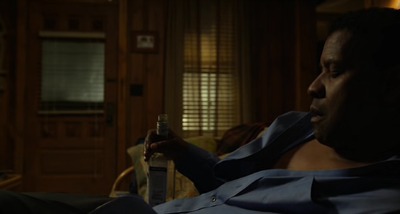
There are of course different ways to show a car crash, depending on the movie genre, the cause of the crash and the impact of the accident.
Often the car scene is split in 3 parts: 1. a peaceful moment before; 2. the crash; 3. the aftermath.
This is the screenplay format of Arbitrage written by Nicholas Jarecki
EXT. HIGHWAY - DEAD OF NIGHT A MERCEDES 450 SEL driving the interstate towards Connecticut. Billie Holiday sings her 1959 "Just One More Chance." We hold on a two-shot through the windshield: Julie rests her head on Robert's shoulder.
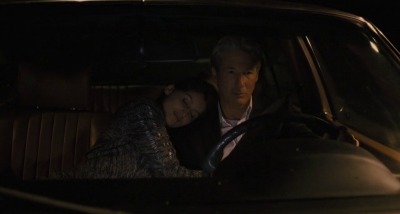
And the camera moves closer into Robert's face, Julie snuggled next to him, Billie's music lulling the moment into tranquility, and finally, just finally, Robert has a moment's respite, as he slowly closes his heavy eyelids, nodding off into a trance of desperately needed sleep until...
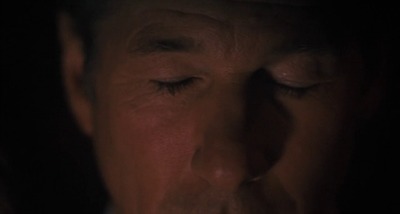
A SCRAPING METALLIC NOISE jolts us back to EXT. HIGHWAY Reality -- as the car drifts into the CENTER MEDIAN where the tire catches on a small metal SCRAP and BLOWS OUT, flipping the car over and over until it CAREENS to a halt.
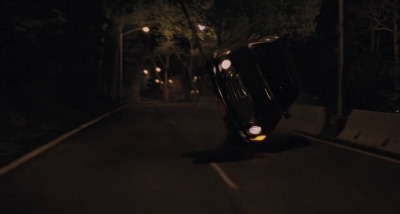
This is one of these places, where the secrets of the characters can often be found. Whiskey, drugs, but most of the time ... a gun.
You achieve the best effect when the object in the compartment surprises the reader or confirms the reader's opinion about the character.
This is the screenplay format of 2 scenes from American Beauty, screenplay written by Alan Bal.
EXT. FREEWAY - CONTINUOUS The MERCEDES-BENZ ML320 is parked in the breakdown lane, its HAZARD LIGHTS BLINKING. Cars ZOOM past in the rain.
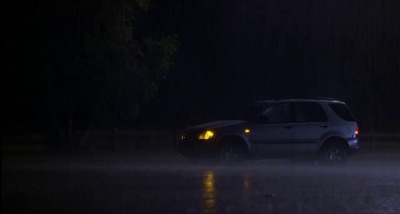
INT. MERCEDES-BENZ ML320 - CONTINUOUS Carolyn sits behind the wheel, listening to a MOTIVATIONAL TAPE on the STEREO. TAPE VOICE --disinvesting problems of their power, and removing their ability to make us afraid. This is the secret to "me- centered" living. Only by taking full responsibility for your problems--and their solutions--will you ever be able to break free from the constant cycle of victimhood. Carolyn leans over and open the glove compartment. She takes out her GLOCK 19.
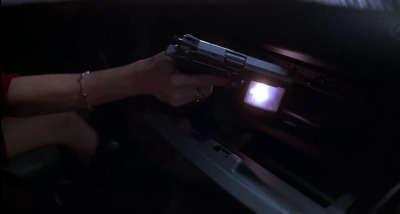
You'll often see the driver watching in the rear-mirror what happens in his car. Alternatively he looks at his rear/side mirror to find out he's chased.
To illustrate the variety of screenplay formats, you'll see below 3 examples:
a) This is from American Beauty, screenplay written by Alan Bal.
INT. MERCEDES-BENZ ML320 - CONTINUOUS CLOSE on Carolyn's eyes, reflected in the REAR-VIEW MIRROR. She turns her head to look out the window: Her POV: The RED DOOR of the Burnham house stands out, even in the pouring rain.
b) A similar situation - this time with a screenplay format not using camera directions (as per formatting commandment # 5) is shown in Enemy of the State, screenplay written by David Marconi
INT. CAB - NIGHT "BRILL" eyes the mirror. A BLACK CHEVY appears several car lengths behind.
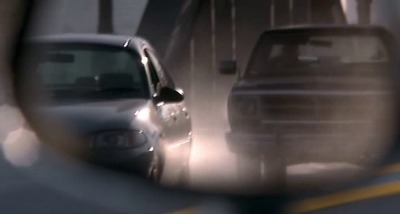
c) Andrew Kevin Walker uses himself 2 screenplay formats in his famous Se7en:
Tracy gets out, neglects to close the door, not looking back. Somerset tries to come to his senses. He doesn't understand either, and his heart is aching. He adjusts the rearview mirror to watch Tracy go. INSERT -- THROUGH REARVIEW MIRROR -- SOMERSET'S P.O.V. Tracy walks down the block, straightening her hair. She runs.
He uses later on a most common version:
INT. MILLS' CAR -- LATE AFTERNOON Mills drives, looking to the back seat through the rearview mirror. A steel mesh partition separates front from back. John Doe sits ...
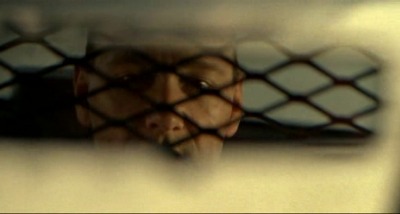
This brings us to our last example. A very frequent situation in movies: being followed by a police patrol car and having to stop.
This is the screenplay format of Thelma & Louise, screenplay written by Callie Khouri.
EXT. DESERT HIGHWAY - DAWN The car is SCREAMING down the road. They drive through a little stand of buildings. EXT. DESERT HIGHWAY - LONG LENS SHOT - DAWN A car speeds up to try and catch them... The red and blue lights pop on. It is a New Mexico State Patrol car.INT. CAR - DAY Louise sees the lights in the rearview mirror. LOUISE'S POV OF THE SPEEDOMETER at 100 mph. Thelma is asleep. LOUISE Shit! Thelma, wake up! Shit! We're gettin' pulled over! Thelma jumps awake. ... Louise pulls the car off the road. The patrol car pulls up right behind them. The lights shine brightly in through the windows. EXT. SIDE OF DESERT HIGHWAY - DAY The PATROLMAN gets out of his car and approaches their car. He comes to the driver's side window. It is rolled up. PATROLMAN'S POV OF LOUISE smiling up at him. He gestures to her to roll her window down. She does. LOUISE Hello, Officer. Is there a problem? PATROLMAN You wanna let me see your license, please?
Whatascript:
This concludes this article on the 6th screenplay formatting commandment: Thou shalt cut to the chase.
Thank you, Formatman.
Formatman:
May the Format be with you!


You may not realize it but by taking this simple action you
empower us to write more articles like that - one Comment/Like/Share at a time.
Thanks for that.
"Thou shalt not lose the reader in translation"
Pictures and screenplay extracts:
-- "The Bourne Supremacy" - Tony Gilroy (screenplay), Paul Greengrass (director), Oliver Wood (director of Photography)
-- "Argo" - Chris Terrio (screenplay), Ben Affleck (director), Rodrigo Prieto (director of Photography)
-- "Flight" - Denzel Washington (Whip), John Gatins (screenplay), Robert Zemeckis (director),Don Burgess (director of Photography)
-- "Arbitrage" - Richard Gere (Robert), Laetitia Casta (Julie), Nicholas Jarecki (screenplay), Nicholas Jarecki (director), Yorick Le Saux (director of Photography)
-- "American Beauty" - Alan Bal (screenplay), Sam Mendes (director), Conrad L. Hall (director of Photography)
-- "Enemy of the State" - David Marconi (screenplay), Tony Scott(director), Daniel Mindel (director of Photography)
-- "Se7en" - Kevin Spacey (John Doe), Andrew Kevin Walker (screenplay), David Fincher (director), Darius Khondji (director of Photography)
-- "Thelma & Louise" - Callie Khouri (screenplay), Ridley Scott (director), Adrian Biddle (director of Photography)
Go from Screenplay Format to Whatascript! Home page
* Avatar, screenplay written by James Cameron